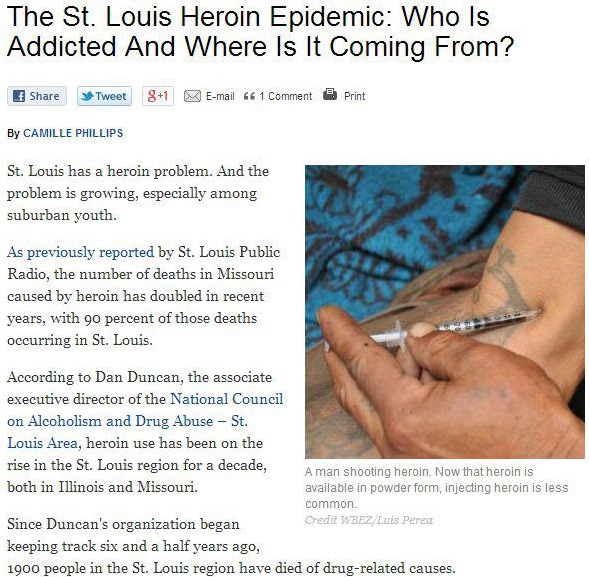There’s an epidemic on the rise and, sadly, it’s not one being caused by a virus or bacteria of some sort. Heroin is pouring in from Chicago, and it’s quickly gaining popularity among youth who have used prescription drugs for recreational purposes in the past.
The issue was the talk of St. Louis On The Air on their March 3, 2014 program on St. Louis Public Radio 90.7 KWMU. Guests on the show were Mark Whitson, a St. Louis County police sergeant; Natalie Moore, a Chicago public radio station reporter who documented the trafficking of heroin into Chicago; and Dan Duncan, the National Council on Alcoholism and Drug Abuse – St. Louis Area executive director.

They noted how the large number of possible pathways makes it difficult for law enforcement to seize the bulk of the drugs making their way into St. Louis. Sergeant Whitson described the influx as drug couriers flooding the country and stretching law enforcement’s reach thin. He noted that drug couriers will use trains, cars, buses, and even boats to transport their cargo and evade the law. In fact, he estimates that law enforcement captures only about 10% of the total load couriers’ transport through the system.
Aside from discussing how heroin is shipped, the guests also discussed possible reasons for the controlled substance’s return to vogue. Among the factors that possibly contributes to this include the following facts:
- Heroin is cheaper now than it used to be. Moore observed that, while addicts used to pay $50 for heroin, the drug can now be bought for $5 or $10.
- Heroin is now available in a powdered form that can be snorted, removing the barrier fear of using needles.
- Some prescription drug addicts are transitioning to heroin because it can be easier to obtain and causes a similar high.
- The nation as a whole is suffering from a laxity in its approach toward drugs, with sentiment leaning stronger toward the idea that they’re not as dangerous as they’re though to be. Duncan remarks that the recent legalization of marijuana may have help to fuel this perception.
With this epidemic quickly spreading throughout the city, the importance of giving addicts drug rehab facilities in St. Louis, MO that they can run to is heightened. As one caller, a recovering teenage heroin addict, notes on the program, many St. Louis teens are not turning to drugs simply because they’re fun, but rather because they want to escape their own personal emotional difficulties.
At a caring St. Louis rehabilitation center, like the Midwest Institute for Addiction, youth who are embattled both against drugs and their own personal problems can get the support they need to overcome these issues.
(Source: The St. Louis Heroin Epidemic: Who Is Addicted And Where Is It Coming From?,St. Louis Public Radio, March 3, 2014)










